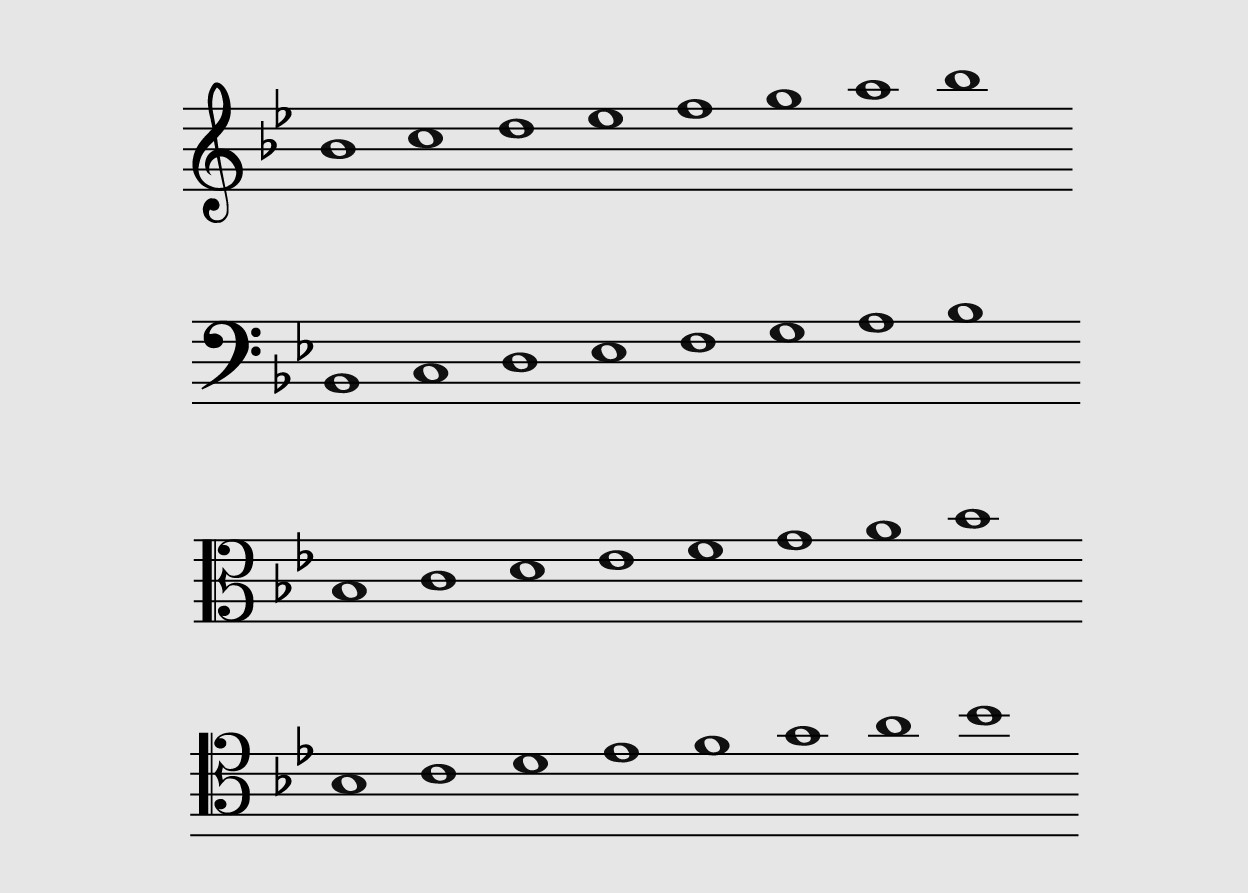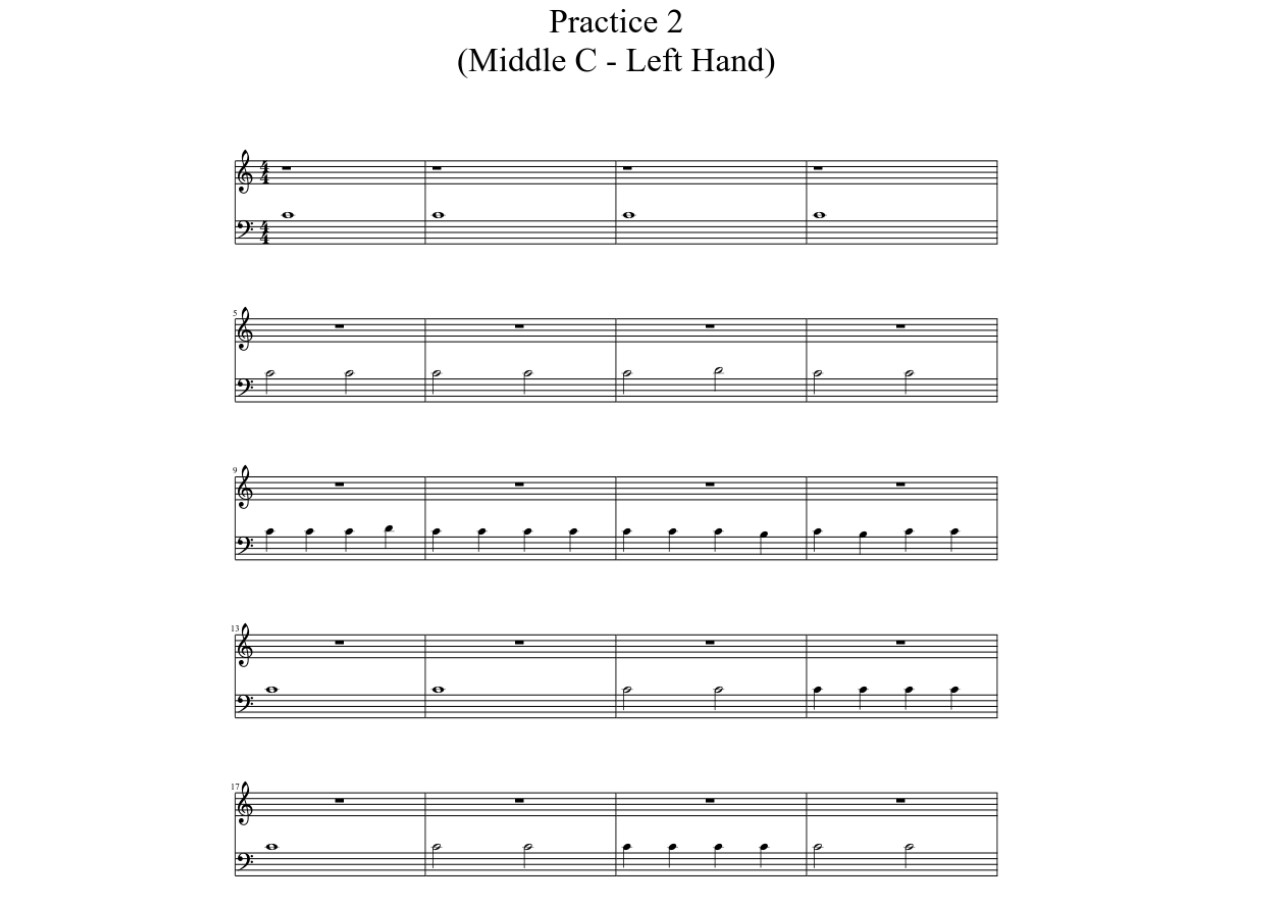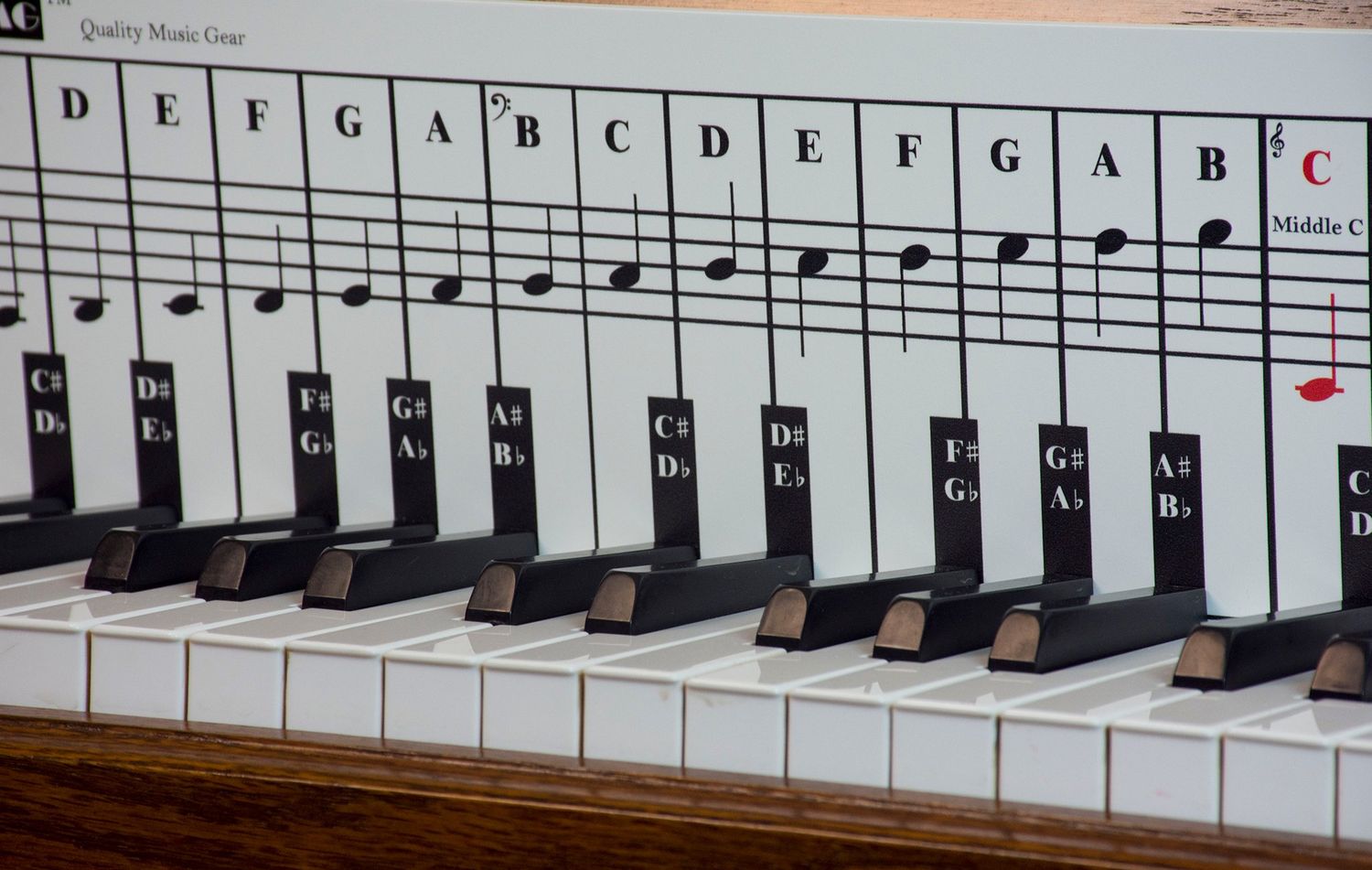Home>Production & Technology>Music Theory>Why Start On C In Music Theory


Music Theory
Why Start On C In Music Theory
Modified: February 9, 2024
Discover the importance and benefits of starting on C in music theory. Learn how it lays a solid foundation for your understanding of key signatures, scales, and chords. Enhance your music theory knowledge today.
(Many of the links in this article redirect to a specific reviewed product. Your purchase of these products through affiliate links helps to generate commission for AudioLover.com, at no extra cost. Learn more)
Table of Contents
Introduction
Welcome to the fascinating world of music theory! Whether you are a beginner musician or a seasoned professional looking to expand your understanding, delving into the realm of music theory is essential for developing a deeper appreciation and mastery of music. At the heart of music theory lies a fundamental question: where should one start? While there are various approaches to this, one widely popular and highly recommended starting point is the key of C.
In this article, we will explore the reasons why starting on C is a solid foundation for music theory. We will look at the importance of learning C as the starting point, the benefits it offers, and how it helps in building a strong musical foundation.
Music theory is the study of how music is constructed, including its structure, harmony, melody, rhythm, and form. It provides a framework for understanding how different musical elements work together to create a cohesive and expressive piece of music. By learning music theory, you will gain the tools and knowledge to analyze, compose, and improvise music more effectively.
Choosing the right starting point in music theory is crucial, as it sets the tone for your musical journey. Starting on C is often recommended for several reasons, which we will explore in the following sections. So, let’s dive in and uncover the significance of C as the starting point in music theory.
The Foundations of Music Theory
Before we delve into the importance of starting on C in music theory, let’s first understand the foundations of this intricate discipline. Music theory is a vast field that encompasses various concepts and principles that govern the creation and organization of music.
At its core, music theory seeks to explain how different musical elements, such as melody, harmony, rhythm, and form, interact with one another to create a cohesive musical composition. It provides musicians with a framework to understand the underlying structure and logic behind the music they play or create.
Among the key components of music theory are scales, chords, intervals, and progressions. Scales are a series of notes organized in ascending or descending order and serve as the building blocks of melodies. Chords are formed by combining multiple notes and provide the harmonic foundation of a piece. Intervals measure the distance between two notes and play a crucial role in creating melodic and harmonic tension. Progressions refer to the sequence of chords in a piece of music, shaping its harmonic structure.
By studying music theory, musicians can gain a deeper understanding of how these elements work together, enabling them to read music more fluently, analyze musical compositions, and improvise with greater creativity and confidence. It is a valuable tool for enhancing musical communication, collaboration, and expression.
Now that we have a basic understanding of the foundations of music theory, let’s explore why starting on C is an excellent choice for beginners in their musical journey.
The Importance of Learning C as the Starting Point
Learning C as the starting point in music theory offers several important advantages. One of the primary reasons is its simplicity. The key of C has no sharps or flats, making it the most straightforward and easiest to grasp for beginners. It serves as a solid foundation for understanding the basic concepts of music theory without the added complexity of accidentals.
Starting on C also allows for a clear understanding of the musical alphabet. The notes in the C major scale are C, D, E, F, G, A, and B, which corresponds to the white keys on a piano. This alignment between the letters of the musical alphabet and the keyboard layout provides a visual and tangible representation of notes, aiding in the learning process.
Furthermore, starting on C helps in developing an intuitive sense of tonality. Since the C major scale contains no sharps or flats, it has a pure and unambiguous sound. This simplicity allows beginners to internalize the sound and characteristics of the major scale, serving as a reference point for understanding other scales and modes.
In addition to its simplicity, learning C as the starting point also allows for easy transposition. Transposition refers to the process of shifting a piece of music to a different key. By beginning with C, beginners can easily transpose melodies and chord progressions to other keys, as the relationship of notes remains consistent without the need for accidentals.
Lastly, starting on C provides a solid groundwork for understanding the circle of fifths. The circle of fifths is a visual representation of the relationships between different key signatures, and it plays a vital role in understanding the harmonic structure of music. Starting on C allows beginners to observe the circle of fifths in its simplest form before progressively exploring more complex key relationships.
Overall, learning C as the starting point in music theory offers simplicity, clarity, and a strong foundation for further learning and exploration. It sets beginners on the right path towards understanding the core concepts of music theory and paves the way for confident and comprehensive musical development.
Benefits of Starting on C in Music Theory
Starting on C in music theory provides several benefits that contribute to a solid understanding and mastery of the subject. Let’s explore these benefits in more detail:
- Simplicity: As mentioned earlier, the key of C has no sharps or flats, making it the simplest key to learn for beginners. This simplicity allows learners to focus on grasping fundamental concepts without the added complexity of accidentals. It provides a clear and straightforward starting point, making it easier to build upon with more advanced concepts.
- Transposition: Starting on C makes transposition more accessible. Transposition is the process of moving a musical piece to a different key. Since the C major scale contains only natural notes, it is easier for beginners to transpose melodies or chord progressions to different keys without the need for additional accidentals. This flexibility broadens the musical possibilities and allows for a deeper understanding of key relationships.
- Visual Representation: The C major scale, with its corresponding white keys on the piano, provides a visual representation of the musical alphabet. This alignment helps beginners visualize and comprehend the relationship between notes, making it easier to navigate through the musical landscape. The visual aspect serves as a powerful learning tool, aiding in memory retention and understanding.
- Understanding Tonality: The key of C major has a pure and unambiguous sound due to its lack of sharps or flats. By starting on C, beginners can develop a strong sense of tonality and internalize the sound of the major scale. This serves as a foundation for recognizing tonal relationships and understanding other scales and modes. A solid understanding of tonality is crucial for composition, improvisation, and more advanced harmonic analysis.
- Exploring the Circle of Fifths: The circle of fifths is a vital tool in music theory, representing the relationships between different key signatures. Starting on C allows beginners to explore the circle of fifths in its simplest form. As learners progress, they can gradually observe the connections between different keys and the harmonic relationships within the circle. This understanding enhances their ability to analyze and compose music with a more comprehensive view of key relationships.
Overall, starting on C in music theory offers simplicity, visual representation, ease of transposition, and a strong foundation in tonality and key relationships. These benefits empower beginners to develop a solid understanding of music theory and lay the groundwork for further exploration and growth in their musical journey.
Understanding the C Major Scale
The C major scale is a fundamental component of music theory and serves as an excellent starting point for beginners. Understanding the structure and characteristics of the C major scale provides a strong foundation for further learning and exploration. Let’s dive into the details of the C major scale:
The C major scale consists of seven notes: C, D, E, F, G, A, and B. These notes follow a specific pattern of whole steps (W) and half steps (H) to create a sequence of intervals. The pattern of intervals for the C major scale is as follows: W-W-H-W-W-W-H.
Starting on C, we move up a whole step to D, another whole step to E, then a half step to F. Continuing, we move up a whole step to G, another whole step to A, and finally a whole step to B. If we were to continue, we would end up at the next C, completing the octave.
The C major scale is unique because it contains no sharps or flats. It is often referred to as the “natural” major scale since it consists of only the notes of the C major key without any alterations.
Understanding the C major scale helps to develop a sense of tonality and key relationships. The pattern of whole steps and half steps allows musicians to recognize the characteristic sound of the major scale and identify it in other keys as well.
Additionally, the C major scale serves as a reference point for understanding the intervals within a scale. For example, the interval between C and E in the C major scale is a major third, while the interval between C and G is a perfect fifth. These intervals play a significant role in building chords and creating harmonic progressions.
The C major scale is not only a crucial building block for understanding major scales, but it also serves as a starting point for other related scales and modes. By exploring the relationships between the C major scale and its relatives, such as the relative minor scale (A minor), the modes (such as D Dorian or G Mixolydian), and the pentatonic scale, musicians can deepen their understanding of music theory.
Overall, understanding the C major scale lays the groundwork for comprehending the structure of scales, identifying intervals, and recognizing tonal relationships. It provides a solid foundation for further exploration and a deeper understanding of music theory.
Building Chords on the C Major Scale
One of the essential aspects of music theory is understanding how chords are constructed. By building chords on the C major scale, we can gain insight into the harmonic possibilities and principles that govern music. Let’s explore how chords are formed on the C major scale:
The C major scale consists of seven notes: C, D, E, F, G, A, and B. Each of these notes can serve as the foundation for a chord. By stacking specific intervals on top of these notes, we can create a variety of chords.
Following the pattern of the major scale, we build chords using the intervals of a third, which is either a major third (M3) or a minor third (m3). Starting with the C note, we can construct the following chords:
- C Major (I): The C major chord consists of the notes C, E, and G. This chord is built by stacking a major third from C to E and then a perfect fifth from E to G. It is denoted as the I chord or the tonic chord.
- D Minor (ii): The D minor chord consists of the notes D, F, and A. It is built by stacking a minor third from D to F and then a perfect fifth from F to A. It is denoted as the ii chord.
- E Minor (iii): The E minor chord consists of the notes E, G, and B. It is built by stacking a minor third from E to G and then a perfect fifth from G to B. It is denoted as the iii chord.
- F Major (IV): The F major chord consists of the notes F, A, and C. It is built by stacking a major third from F to A and then a perfect fifth from A to C. It is denoted as the IV chord.
- G Major (V): The G major chord consists of the notes G, B, and D. It is built by stacking a major third from G to B and then a perfect fifth from B to D. It is denoted as the V chord.
- A Minor (vi): The A minor chord consists of the notes A, C, and E. It is built by stacking a minor third from A to C and then a perfect fifth from C to E. It is denoted as the vi chord.
- B Diminished (vii°): The B diminished chord consists of the notes B, D, and F. It is built by stacking a minor third from B to D and then another minor third from D to F. It is denoted as the vii° chord.
These seven chords formed from the C major scale are commonly referred to as the diatonic chords. Understanding how these chords are constructed provides a strong foundation for chord progressions, harmonizing melodies, and creating musical arrangements.
By exploring chord progressions within the C major scale, musicians can begin to develop an understanding of the relationships and tension between chords. The root position, inversions, and extensions of these chords further expand the harmonic possibilities and add complexity to compositions.
Building chords on the C major scale is a crucial step in understanding harmony and creating harmonic structures in music. By mastering the chord construction process, musicians gain the ability to analyze and create captivating chord progressions that complement melodies and express emotions effectively.
Developing a Solid Musical Foundation with C as the Starting Point
Starting on C in music theory provides a solid foundation for building a comprehensive and well-rounded understanding of music. By beginning with the key of C, musicians can develop a strong musical foundation that serves as a springboard for further growth and exploration. Let’s explore how starting on C contributes to a solid musical foundation:
Understanding the Basics: Starting on C allows beginners to grasp the fundamental concepts of music theory with simplicity and clarity. The absence of sharps or flats in the C major scale makes it easier to comprehend and identify the notes and intervals within the scale. This understanding provides a solid base upon which more complex concepts and theories can be built.
Developing Ear Training: Starting on C helps in developing ear training skills. Since the C major scale has a distinct and unambiguous sound, beginners can train their ears to recognize the unique characteristics of this scale. This ability to identify and differentiate musical sounds fosters a deeper understanding of tonality and helps in developing a keen sense of pitch and harmony.
Building Chord Vocabulary: By starting on C, musicians can systematically learn and build their chord vocabulary. The diatonic chords derived from the C major scale serve as a foundation for understanding harmonies and chord progressions. Learning how to construct and apply various chords on the C major scale opens up a world of creative possibilities for composing, arranging, and improvising.
Visual Representation: The visual representation of the C major scale, particularly on a piano keyboard, provides a clear and intuitive framework for understanding the relationships between notes and intervals. This visual connection helps beginners visualize and internalize music theory concepts, making it easier to navigate the musical landscape and apply theoretical knowledge practically.
Transpositional Skills: Starting on C allows for easy transposition to different keys. By starting on a key without sharps or flats, musicians can easily transpose melodies, chord progressions, and other musical elements to other keys without the added complexity of accidentals. This flexibility in transposition builds valuable skills for playing in different musical contexts and unlocking a broader repertoire of music.
Enhancing Analytical Abilities: Starting on C provides a solid starting point for analyzing musical compositions. By understanding the key of C major and its related scales and modes, musicians can analyze the harmonic structure, identify melodic patterns, and make connections between different musical elements. This analytical skill enhances musical comprehension and interpretation.
Overall, starting on C in music theory lays the groundwork for a solid musical foundation. It fosters an understanding of the basic principles, develops ear training skills, builds chord vocabulary, provides a visual representation, enhances transpositional abilities, and boosts analytical capabilities. This strong foundation equips musicians with the necessary tools to explore and excel in various musical pursuits.
Conclusion
Starting on C in music theory provides a strong foundation for beginners and aspiring musicians. By beginning with the key of C, learners can develop a comprehensive understanding of music theory that sets the stage for further growth and exploration. The importance of learning C as the starting point cannot be overstated.
Choosing the key of C offers several benefits. Its simplicity and lack of sharps or flats make it an accessible starting point for beginners. Understanding the C major scale provides a clear understanding of the musical alphabet, assists in developing tonal intuition, and aids in visualizing musical concepts on instruments like the piano.
Building chords on the C major scale opens up possibilities for harmonizing melodies, creating chord progressions, and understanding the principles of harmony. Moreover, starting on C helps musicians sharpen their ear training skills, develop transpositional abilities, and enhance their analytical understanding of music.
By starting on C, learners lay the groundwork for a solid musical foundation. This foundation equips musicians with the tools they need to navigate the vast world of music theory. It serves as a solid springboard for further exploration, allowing musicians to dive into more complex concepts and delve into different keys, scales, and modes with confidence.
In conclusion, starting on C in music theory is a wise choice for beginners. From its simplicity to its visual representation, from its impact on ear training to its transpositional flexibility, starting on C provides a strong and solid starting point for musicians’ musical journey. Embrace the power of C and unlock the vast potential of music theory.











